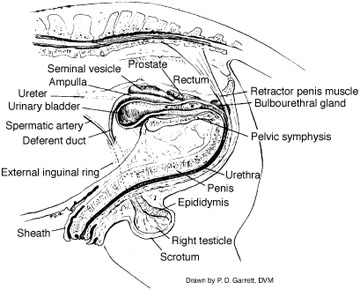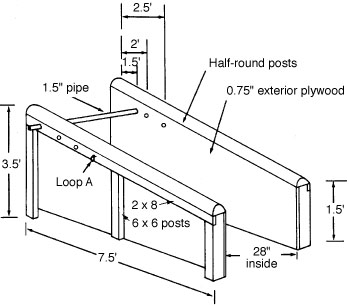Role of the Stallion in Reproduction
The stallion must deliver healthy spermatozoa (which contain his genetic contribution) into the vagina of the mare at time of service. He should have enough libido (sex drive) to tease and service frequently and be able to sustain production of healthy spermatozoa throughout the breeding season (Table 1).
| Volume per ejaculate | 25 to 150mL |
| Sperm per cubic millimeter | 60,000 |
| Total sperm in ejaculate | 6,000,000,000 |

The male reproductive system (Figure 1.) consists of two testes, three accessory sex glands and a series of tubules through which spermatozoa are transported to the female reproductive tract.
Spermatozoa are produced in small coiled seminiferous tubules in the testes that can be extended 400 to 500 feet in length. Since these developing cells cannot live at body temperature, heat regulation of the testes is critical. Scrotal muscles contract and expand as temperatures change in the normal process of temperature regulation. “Ridgling” or cryptorchid horses are sterile in the testis maintained in the body cavity, but are fertile in the suspended testis. Since this condition is hereditary, it should not be propagated, as castration of a cryptorchid horse is usually a serious operation.
The accessory sex glands are the seminal vesicles, prostate and bulbourethral gland. These furnish alkaline fluid secretions that neutralize the urethra, through which spermatozoa are transported from the epididymis to the end of the male genitalia glans penis.
The sperm life in the mare’s tract is from 24 to 48 hours. Only in highly irregular or exceptional cases does it exceed this time span. Sperm has been found in the Fallopian tube 15 to 18 minutes after coitus, but the normal time to travel from the site of deposit to the Fallopian tube is five to eight hours. The average egg life is also only five to eight hours.
Because of a long estrous cycle and short life span of the spermatozoa and egg, it is not uncommon to have a lower than 50 percent conception rate.
Care and use of a healthy stallion
Breeding rates
Yearlings should not be used for breeding. Two-year-olds may settle 10 mares; 3-year-olds, 30; and mature stallions, 50 mares when hand-mated. About half this number can be pasture-mated. A short breeding season will reduce the number, and sexual individuality of the stallion will greatly affect his siring ability.
Feeding and management
The breeding stallion should be fed like a horse at hard work. An estimate is 1-1/2 pounds of grain and 1 pound of hay per 100 pounds body weight. If he is worked under saddle, more feed will be required. Because of diverted interests, a ration high in palatability may be necessary for some stallions to get adequate intake.
- Regular exercise usually results in increased vigor (libido) and fertility.
- Regular grazing of good grass, even for short periods of time, is recommended.
- For safety’s sake, fences should be strong and tall when stallions are grazed loose; and mares should not be in adjoining pastures unless extremely tall fences are used.
Methods of mating
Pasture mating, hand mating and artificial insemination are the three methods used, with variations of each. Breed registry regulations vary regarding the use of artificial insemination.
Information on constructing a breeding stall is given in Figure 3. Information on constructing a teasing stall is given in Figure 4.


Pasture mating reduces labor, affords convenience to the owner, “catches” shy breeding mares, and creates an opportunity for a high settling percentage. It has the disadvantage of reducing the number of mares a stallion can serve and obscures breeding dates. Some risk to the stallion exists.
Stallions should be hand-mated a few times as 2-year-olds, then turned in a large pasture with a few older mares when they are to be used in a pasture breeding program. Even so, they are likely to carry some scars from their experience. For this reason, pasture mating is seldom used with breeds whose owners discriminate against blemishes, whereas it is extensively practiced with stock horses in the range country.
A combination of hand mating followed by pasture mating will extend the number of mares bred and increase settling percentage.
Hand mating is practiced under a wide variety of conditions, ranging from rather casual selection of mares and sanitation conditions to those that are highly supervised with a veterinarian in attendance.
Stallions used with hand mating should be adept at teasing mares. This may be done at a teasing pole, over a stall door, or any other sturdy fixture that does not injure the horses or attendants.
Signs of heat are frequent urination, vaginal discharge and intensified interest in the stallion. As ovulation approaches, hormones released by the ripening follicle cause an intensification of these signs. The character of vaginal discharge may change from limited amounts of stringy consistency to profuse amounts of liquid consistency.
After the mare has been teased and found in heat, she may be hobbled or placed in a breeding stock. Hobbles have the advantage of convenience and safety to the mare but may entail some risk to the operator. Stallions also have been known to become entangled in them.
The mare’s hindquarters may be washed in mild soap and rinsed, and her tail bandaged with a roller bandage. The stallion is allowed to mount quietly from directly behind the mare when ready. A stallion should not be permitted to be rough in the process of breeding. Front shoes should be removed before the breeding season.
- How to increase your percent foal crop
- Breed only healthy animals.
- Breed as often in the heat cycle as possible.
- Pasture breed when practical.
- Don’t breed at foal heat.
- Have mares in good condition, but not fat when bred.
- Know the characteristics of each mare’s heat cycle.
- Tease mares regularly after breeding.
- Have mares pregnancy-checked by a competent veterinarian.
Reference
Andrews, F.N., and F.F. McKenzie. 1941. Estrus, Ovulation and Related Phenomena in the Mare. Missouri Agricultural Research Bulletin 329. University of Missouri-Columbia.
Loch, Wayne and John W. Massey. Horse Breeding Basics. 2000. Horse Breeding Arithmetic: 2+2=1. Missouri Agricultural Research Bulletin 2790. University of Missouri-Columbia.



